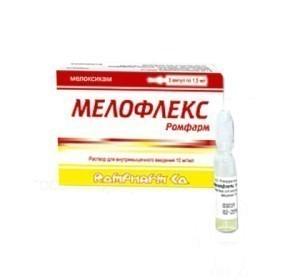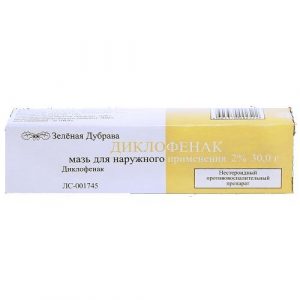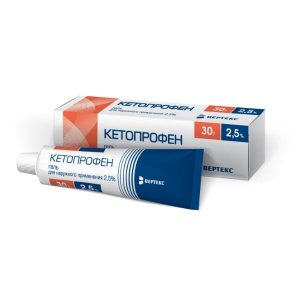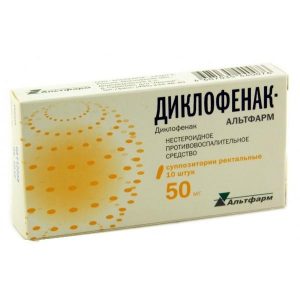Description
Release form
Solution for i / m administration.
Packaging
In the packaging of 3 and 5 ampoules of 1.5 ml.
Pharmacological action
Meloflex Rompharm – NSAIDs, refers to derivatives of enolic acid and has anti-inflammatory, analgesic and antipyretic effects. The pronounced anti-inflammatory effect of meloxicam is established on all standard models of inflammation. The mechanism of action of meloxicam is its ability to inhibit the synthesis of prostaglandins – known mediators of inflammation. In vivo, meloxicam inhibits the synthesis of prostaglandins at the site of inflammation to a greater extent than in the mucous membrane of the stomach or kidneys. These differences are associated with a more selective inhibition of cyclooxygenase-2 (COX-2) compared with cyclooxygenase-1 (COX-1). It is believed that inhibition of COX-2 provides a therapeutic effect of NSAIDs, while inhibition of the constantly present COX-1 isoenzyme can cause side effects from the stomach and kidneys. The selectivity of meloxicam in relation to COX-2 is confirmed in various test systems, both in vitro and ex vivo. The selective ability of meloxicam to inhibit COX-2 is shown when using in vitro human whole blood as a test system. Ex vivo found that meloxicam (at doses of 7.5 mg and 15 mg) more actively inhibited COX-2, having a greater inhibitory effect on the production of prostaglandin E2 stimulated by lipopolysaccharide (a reaction controlled by COX-2) than on the production of thromboxane, which is involved in the coagulation process blood (reaction controlled by COX-1). These effects were dose dependent. Ex vivo showed that meloxicam at the recommended doses did not affect platelet aggregation and bleeding time, unlike indomethacin, diclofenac, ibuprofen, and naproxen, which significantly inhibited platelet aggregation and increased bleeding time.
Indications
rheumatoid arthritis
osteoarthritis
ankylosing spondylitis (ankylosing spondylitis).
Designed for symptomatic therapy, reduce pain and inflammation at the time of use, does not affect the progression of the disease.
Contraindications
Conditions accompanied by severe psychomotor agitation, aggressiveness, or deep depression.
Respiratory failure at the stage of decompensation.
Syndrome of respiratory arrest in a dream (history).
Concomitant use with tacrolimus, sirolimus, cyclosporine.
I trimester of pregnancy.
Lactation (breastfeeding).
Hypersensitivity to the drug or any other benzodiazepine.
Caution is advised to prescribe the drug in the following cases:
Uncompensated chronic respiratory distress syndrome.
A history of acute respiratory failure.
Angle-closure glaucoma.
epilepsy.
Organic brain damage (e.g., atherosclerosis). non-dialyzable (CC less than 30 ml / min)
progressive kidney disease
severe liver failure or active liver disease
condition after coronary artery bypass grafting
confirmed hyperkalemia
inflammatory bowel disease
children and adolescents up to 18 years of sensitivity srd
hypersensitivity to other NSAIDs.
Precautions: elderly, coronary heart disease, chronic heart failure, cerebrovascular disease, dyslipidemia / hyperlipidemia, diabetes mellitus, peripheral artery disease, smoking, chronic renal failure (CC 30-60 ml / min), history of gastrointestinal ulceration, infection Helicobacter pylori, prolonged use of NSAIDs, alcoholism, severe somatic diseases, concomitant use of oral GCS (including prednisone), anticoagulants (including warfarin), antiplatelet agents (including clopidogrel), selective serotonin reuptake inhibitors (including citalopram, fluoxetine, paroxetine, sertraline).
Use during pregnancy and lactation
Teratogenic effects. Meloxicam increased the frequency of cardiac septal defects (a rare complication) when using an oral dose of 60 mg / kg / day (64.5 times the dose of 15 mg / day for an adult weighing 50 kg in terms of body surface area) and embryo-lethality with oral doses 5 mg / kg / day (5.4 times the dose for humans, as described above) in rabbits who received meloxicam during organogenesis. Meloxicam did not show teratogenicity in rats at oral doses of 4 mg / kg / day (about 2.2 times the dose for humans, as described above) during organogenesis. An increase in the stillbirth rate was observed in rats with oral doses of 1 mg / kg / day during organogenesis.
Non-teratogenic effects. Meloxicam caused a decrease in indicators such as the birth rate, live birth, neonatal survival at oral doses of 0.125 mg / kg / day (approximately 0.07 times the dose for humans, as described above) in rats during pregnancy and lactation.
Meloxicam crosses the placental barrier. Adequate and strictly controlled studies in pregnant women have not been conducted. Use during pregnancy is possible if the expected effect of therapy exceeds the potential risk to the fetus.
No studies have been conducted to evaluate the effect of meloxicam on closure of the ductus arteriosus in humans. The use of meloxicam in the third trimester of pregnancy should be excluded.
Childbirth and delivery. In studies in rats, it was shown that meloxicam, like other agents that inhibit the synthesis of PG, increases the number of stillbirths, causes a delay in childbirth and delivery at oral doses of 1 mg / kg / day (about 0.5 times the dose for humans, as described above) and reduces the number of surviving cubs with oral doses of 4 mg / kg / day (about 2.1 times the dose for humans, as described above) during organogenesis. Similar observations were observed in rats receiving oral doses of 0.125 mg / kg / day (approximately 0.07 times the dose for humans, as described above) during pregnancy and lactation.
The effects of meloxicam on childbirth and delivery in humans are unknown.
FDA category of action on the fetus is C.
The use of meloxicam, like other drugs that block the synthesis of PG, can affect fertility, so it is not recommended for women who want to become pregnant. Meloxicam is excreted in the milk of lactating rats, while the concentration in the milk exceeds the concentration in the plasma. It is not known whether meloxicam passes into breast milk of women, therefore, breast-feeding should be discontinued during treatment or the use of meloxicam during breast-feeding should be avoided.
Composition
1 ml. solution for intramuscular administration contains:
Active ingredient: meloxicam 10 mg
Excipients: meglumine – 6.25 mg, glycofurfural – 100 mg, poloxamer 188 – 50 mg, glycine – 5 mg, sodium chloride – 3.5 mg, sodium hydroxide solution 1M – pH 8.6-9, water d / i – up to 1 ml.
Dosage and administration
The drug is administered deeply intramuscularly. It is contraindicated intravenously.
Intramuscular administration of the drug is indicated only during the first days of treatment. Further treatment is continued with the use of oral forms (tablets).
Osteoarthrosis in the acute phase: 7.5 mg per day, if the condition does not improve, you can increase the dose to 15 mg per day.
Rheumatoid arthritis, ankylosing spondylitis: 15 mg per day. Depending on the therapeutic effect, the dose can be reduced to 7.5 mg per day. The daily dose of meloxicam 15 mg should not be exceeded.
In elderly patients, the recommended dose for long-term therapy of rheumatoid arthritis or ankylosing spondylitis is 7.5 mg per day. In patients with an increased risk of side effects, therapy should be started with a dose of 7.5 mg per day.
In dialysis patients with severe renal failure, the daily dose of meloxicam 7.5 mg should not be exceeded. In patients with mild or moderate renal impairment (CC more than 25 ml / min), there is no need to reduce the dose.
In patients with mild or moderate hepatic impairment, there is no need to reduce the dose of the drug.
Side effects of the
Digestive system: often – dyspepsia, including nausea, vomiting, abdominal pain, constipation, flatulence, diarrhea infrequently – a transient increase in hepatic transaminase activity, hyperbilirubinemia, belching, esophagitis, gastroduodenal ulcer, gastrointestinal bleeding (including hidden), stomatitis rarely – gastrointestinal perforation, colitis, gastritis.
From the side of hematopoietic organs: often – anemia infrequently – a change in the blood formula, incl. leukopenia, thromocytopenia.
From the skin: often – itching, rash infrequently – urticaria rarely – photosensitivity, bullous rashes, erythema multiforme, incl. Stevens-Johnson syndrome, toxic epidermal necrolysis.
From the respiratory system: infrequently – the occurrence of attacks of bronchial asthma in people allergic to acetylsalicylic acid or other NSAIDs.
From the side of the central nervous system: often – dizziness, headache infrequently – vertigo, tinnitus, drowsiness rarely – confusion, disorientation, emotional lability.
From the cardiovascular system: often – peripheral edema infrequently – increased blood pressure, sensation of palpitations, flushing of the face.
From the urinary system: infrequently – hypercreatininemia and / or an increase in the concentration of urea in the blood serum rarely – acute renal failure, no connection with meloxicam has been established – interstitial nephritis, albuminuria, hematuria.
On the part of the sensory organs: rarely – conjunctivitis, visual impairment, including blurred visual perception.
Allergic reactions: rarely – angioedema, anaphylactoid / anaphylactic reactions.
Drug Interaction
Pharmacodynamic Interaction
Concurrent administration of several NSAIDs (including salicylates) may increase the risk of erosive-ulcerative gastrointestinal lesions due to synergistic effects, so use of meloxicam is not recommended.
When using meloxicam with diuretics, the patient should use sufficient amount of fluid, as well as regular medical monitoring of kidney function before beginning and during treatment.
Combined use with indirect anticoagulants increases the risk of bleeding due to inhibition of platelet function and damage to the gastric and intestinal mucosa. Therefore, it is not recommended to use in combination with NSAIDs and indirect anticoagulants.
With the combined use of thrombolytic and antithrombotic drugs with meloxicam, an increased risk of bleeding may occur (periodic monitoring of blood clotting parameters is required).
Concomitant use with ACE inhibitors and other antihypertensive drugs in elderly patients with symptoms of dehydration may trigger the development of acute renal failure. In addition, combined with meloxicam may reduce their antihypertensive effect.
Meloxicam increases the nephrotoxic effect of cyclosporine.
Meloxicam may reduce the effectiveness of contraceptives.
The pharmacokinetic interaction of
NSAIDs may increase serum lithium concentrations to a toxic level (decrease in renal lithium excretion). Therefore, concomitant use of meloxicam with lithium preparations is not recommended. If necessary, their combined use should carefully monitor the content of lithium in the serum before the start, during and after the course of therapy with meloxicam and lithium preparations.
When used with methotrexate, adverse effects on the hematopoietic system are increased (risk of anemia and leukopenia). Periodic control of the hemogram is required.
Cholestyramine accelerates the elimination of meloxicam, increasing meloxicam clearance by 50%, reducing its T1 / 2 by 13 ± 3 h. This interaction is clinically relevant.
No significant clinical interaction observed with antacids, cimetidine and digoxin.
NSAIDs reduce the effectiveness of contraceptive intrauterine devices.
When used with meloxicam and drugs that have a known ability to inhibit CYP2C9 and / or CYP3A4 (or are metabolized with the participation of these enzymes), the possibility of pharmacokinetic interaction should be considered. The possibility of interaction of meloxicam with oral hypoglycemic agents cannot be excluded.
The concomitant use of meloxicam with selective serotonin reuptake inhibitors increases the risk of gastrointestinal bleeding.
Overdose
Increased dose-related side effects.
Symptoms: impaired consciousness, nausea, vomiting, epigastric pain, gastrointestinal bleeding, acute renal failure, acute liver failure, respiratory arrest, asystole.
Treatment: symptomatic therapy. Forced diuresis, alkaline urination, hemodialysis are ineffective due to the high degree of binding of meloxicam to plasma proteins. There is no specific antidote.
Storage conditions
The drug should be stored out of the reach of children, protected from light, at a temperature not exceeding 25 ° C.
Expiration
4 years.
Active ingredient
Meloxicam
Pharmacy terms
Prescription
dosage form
dosage form
injection




